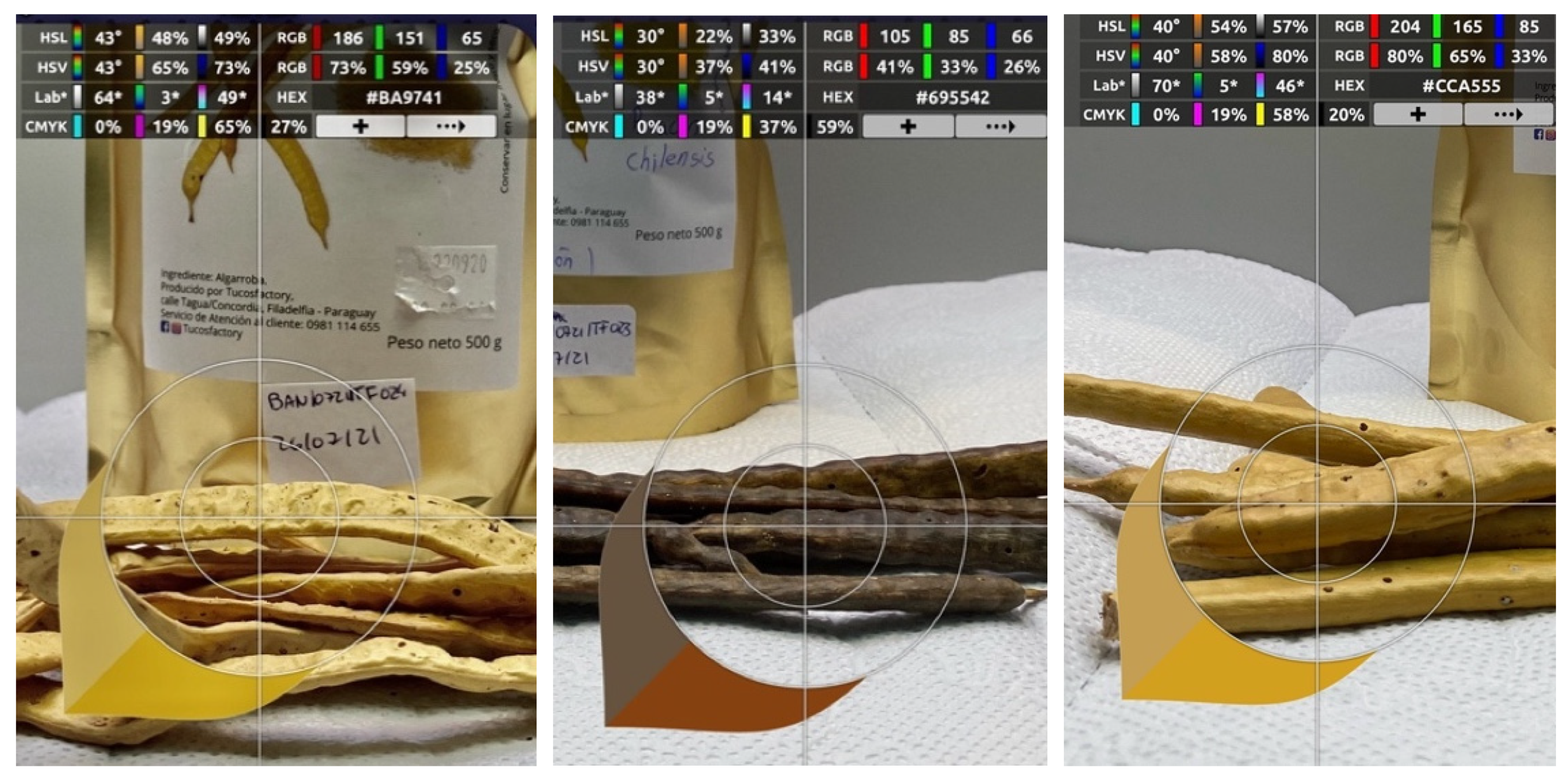Variations in the Composition of “Algarrobas” (Prosopis sp.) Flours from Paraguayan Chaco †
Abstract
1. Introduction
2. Materials and Methods
2.1. Sampling
2.2. Analytical Methods
2.3. Statistical Analysis
3. Results and Discussion
3.1. Physicochemical Characteristics and Antioxidants
3.2. Microbiological Analysis
4. Conclusions
Author Contributions
Funding
Institutional Review Board Statement
Informed Consent Statement
Data Availability Statement
Acknowledgments
Conflicts of Interest
References
- Cardozo, M.L.; Ordoñez, R.M.; Zampini, I.C.; Cuello, A.S.; Dibenedetto, G.; Isla, M.I. Evaluation of Antioxidant Capacity, Genotoxicity and Polyphenol Content of Non Conventional Foods: Prosopis Flour. Food Res. Int. 2010, 43, 1505–1510. [Google Scholar] [CrossRef]
- Merchant, E.V.; Simon, J.E. Traditional and Indigenous Foods for Food Security and Sovereignty. In Reference Module in Food Science; Elsevier: Amsterdam, The Netherlands, 2022. [Google Scholar]
- Cattaneo, F.; Costamagna, M.S.; Zampini, I.C.; Sayago, J.; Alberto, M.R.; Chamorro, V.; Pazos, A.; Thomas-Valdés, S.; Schmeda-Hirschmann, G.; Isla, M.I. Flour from Prosopis Alba Cotyledons: A Natural Source of Nutrient and Bioactive Phytochemicals. Food Chem. 2016, 208, 89–96. [Google Scholar] [CrossRef] [PubMed]
- Singleton, V.L.; Orthofer, R.; Lamuela-Raventós, R.M. Analysis of Total Phenols and Other Oxidation substrates and antioxidants by means of folin-ciocalteu reagent. In Methods in Enzymology; Academic Press: Cambridge, MA, USA, 1999; Volume 299, pp. 152–178. [Google Scholar]
- Re, R.; Pellegrini, N.; Proteggente, A.; Pannala, A.; Yang, M.; Rice-Evans, C. Antioxidant Activity Applying an Improved ABTS Radical Cation Decolorization Assay. Free Radic. Biol. Med. 1999, 26, 1231–1237. [Google Scholar] [CrossRef]
- Galera, F.M.; Food and Agriculture Organization; Plant Production and Protection Division; Universidad Nacional de Córdoba (Argentina). Las Especies del Género Prosopis (algarrobos) de América Latina con Especial Énfasis en Aquellas de Interés Económico; Universidad Nacional de Córdoba: Córdoba, Argentina, 2000. (In Spanish) [Google Scholar]
- Michajluk, J.; Mereles, L.; Wiszovaty, L.; Piris, P.; Caballero, S. Evaluación preliminar y del valor nutricional de vainas de Prosopis alba y Prosopis chilensis cosechadas en comunidades indígenas del Dpto. Boquerón, Chaco. Rojasiana. 2009, 8, 59–64. (In Spanish) [Google Scholar]
- González Galán, A.; Corrêa, A.D.; Abreu, C.M.P.; de Fatima, M.; Barcelos, P. Caracterización química de la harina del fruto de Prosopis spp. procedente de Bolivia y Brasil. Arch. Latinoam. Nutr. 2008, 58, 309–315. (In Spanish) [Google Scholar]

| Compounds | Prosopis alba (White) | Prosopis chilensis (Yellow) | Prosopis chilensis (Brown) |
|---|---|---|---|
| Moisture (g/100 g) | 5.62 ± 0.22 a | 4.31 ± 0.31 b | 4.55 ± 0.37 b |
| Ash (g/100 g) | 5.46 ± 0.15 a | 4.21 ± 0.10 c | 4.86 ± 0.18 b |
| Total lipids (g/100 g) | 1.94 ± 0.18 a | 2.79 ± 0.10 b | 2.22 ± 0.22 a |
| Total proteins (g/100 g) | 7.31 ± 0.42 a | 9.41 ± 0.44 c | 10.70 ± 0.25 b |
| Dietary fiber (g/100 g) | 31.06 ± 2.65 a | 25.67 ± 1.81 b | 32.15 ± 3.47 a |
| Carbohydrates (g/100 g) | 48.33 ± 3.38 a | 58.13 ± 1.55 b | 53.37 ± 8.19 ab |
| Caloric value (kcal/100 g) | 240.01 ± 14.8 a | 295.27 ± 7.0 b | 276.26 ± 9.1 b |
| Recuento de Colonias (UFC/g) | |||||
|---|---|---|---|---|---|
| Flour Samples | Mesophilic Aerobes | Total Coliforms | Fecal Coliforms | Molds | Yeasts |
| P. alba (white) | 6.8 × 103 | 4.4 × 103 | - | ≤101 | 6.0 × 103 |
| P. chilensis (brown) | 8.8 × 103 | 5.0 × 102 | - | ≤101 | 4.3 × 103 |
| P. chilensis (yellow) | 7.5 × 103 | 6.1 × 102 | - | ≤101 | 5.0 × 103 |
Publisher’s Note: MDPI stays neutral with regard to jurisdictional claims in published maps and institutional affiliations. |
© 2022 by the authors. Licensee MDPI, Basel, Switzerland. This article is an open access article distributed under the terms and conditions of the Creative Commons Attribution (CC BY) license (https://creativecommons.org/licenses/by/4.0/).
Share and Cite
Villalba, R.; Denis Ibars, J.; Martínez, K.; Coronel, E.; Friesen, A.; Mereles, L. Variations in the Composition of “Algarrobas” (Prosopis sp.) Flours from Paraguayan Chaco. Biol. Life Sci. Forum 2022, 17, 25. https://doi.org/10.3390/blsf2022017025
Villalba R, Denis Ibars J, Martínez K, Coronel E, Friesen A, Mereles L. Variations in the Composition of “Algarrobas” (Prosopis sp.) Flours from Paraguayan Chaco. Biology and Life Sciences Forum. 2022; 17(1):25. https://doi.org/10.3390/blsf2022017025
Chicago/Turabian StyleVillalba, Rocio, Juan Denis Ibars, Karen Martínez, Eva Coronel, Adeline Friesen, and Laura Mereles. 2022. "Variations in the Composition of “Algarrobas” (Prosopis sp.) Flours from Paraguayan Chaco" Biology and Life Sciences Forum 17, no. 1: 25. https://doi.org/10.3390/blsf2022017025
APA StyleVillalba, R., Denis Ibars, J., Martínez, K., Coronel, E., Friesen, A., & Mereles, L. (2022). Variations in the Composition of “Algarrobas” (Prosopis sp.) Flours from Paraguayan Chaco. Biology and Life Sciences Forum, 17(1), 25. https://doi.org/10.3390/blsf2022017025







